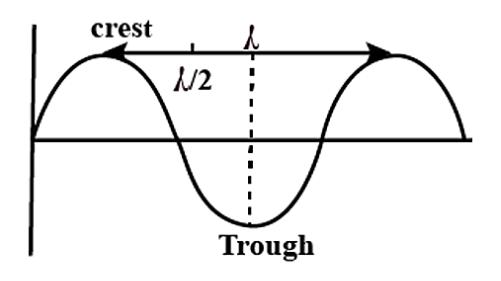
What is the wavelength if the distance between a crest and an immediate trough in a transverse wave is $15m$?
$\begin{align}
& A.30m \\
& B.40m \\
& C.50m \\
& D.15m \\
\end{align}$
Answer
577.2k+ views
Hint: First of all draw a diagram of a transverse wave and mark the crest and the trough. The distance between these will be equal to half of the wavelength of the wave. Substitute the values in this equation and find the answer.
Complete step by step answer:
Wavelength is the distance between the identical points, that is, consecutive crests in the consecutive cycles of a waveform signal which is propagated in space or along a wire. The length is taken in meters usually. In short, we can say that the wavelength is given as the distance between adjacent crest and crest or trough and trough.
Here in this question, it is mentioned that the distance has been measured between a crest and adjacent trough.

Hence we can say that the distance between the consecutive crest and trough will be equal to half of the wavelength of the wave.
Therefore we can write that,
$15=\dfrac{\lambda }{2}$
Where $\lambda $ the wavelength given in meters is.
Rearranging this equation will give,
$\lambda =30m$
Therefore the correct answer is option A.
Note: In a transverse wave, the particles of the medium are in motion perpendicular to the direction of the wave to travel. Transverse waves have properties by peaks and valleys, known as crests and troughs. In a longitudinal wave, the particles of the medium are in motion parallel to the direction of the wave of travel. Light is a transverse wave since its components are in vibration perpendicular to the direction of propagation. This is a major example of a transverse wave. And also sound is an example of longitudinal waves.
Complete step by step answer:
Wavelength is the distance between the identical points, that is, consecutive crests in the consecutive cycles of a waveform signal which is propagated in space or along a wire. The length is taken in meters usually. In short, we can say that the wavelength is given as the distance between adjacent crest and crest or trough and trough.
Here in this question, it is mentioned that the distance has been measured between a crest and adjacent trough.

Hence we can say that the distance between the consecutive crest and trough will be equal to half of the wavelength of the wave.
Therefore we can write that,
$15=\dfrac{\lambda }{2}$
Where $\lambda $ the wavelength given in meters is.
Rearranging this equation will give,
$\lambda =30m$
Therefore the correct answer is option A.
Note: In a transverse wave, the particles of the medium are in motion perpendicular to the direction of the wave to travel. Transverse waves have properties by peaks and valleys, known as crests and troughs. In a longitudinal wave, the particles of the medium are in motion parallel to the direction of the wave of travel. Light is a transverse wave since its components are in vibration perpendicular to the direction of propagation. This is a major example of a transverse wave. And also sound is an example of longitudinal waves.
Recently Updated Pages
Why are manures considered better than fertilizers class 11 biology CBSE

Find the coordinates of the midpoint of the line segment class 11 maths CBSE

Distinguish between static friction limiting friction class 11 physics CBSE

The Chairman of the constituent Assembly was A Jawaharlal class 11 social science CBSE

The first National Commission on Labour NCL submitted class 11 social science CBSE

Number of all subshell of n + l 7 is A 4 B 5 C 6 D class 11 chemistry CBSE

Trending doubts
What is meant by exothermic and endothermic reactions class 11 chemistry CBSE

10 examples of friction in our daily life

One Metric ton is equal to kg A 10000 B 1000 C 100 class 11 physics CBSE

1 Quintal is equal to a 110 kg b 10 kg c 100kg d 1000 class 11 physics CBSE

Difference Between Prokaryotic Cells and Eukaryotic Cells

What are Quantum numbers Explain the quantum number class 11 chemistry CBSE




